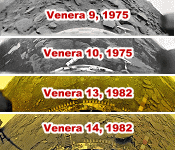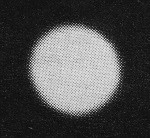|
 Per this 1962 Popular
Science magazine article, while awaiting Mariner 2's historic sweep past the
cloud-shrouded planet of Venus, experts of imagined Earth's nearest neighbor
alternately as a lush prehistoric swamp-world, a dust-choked desert, an endless
steamy ocean, or a tar-lake Hades reeking with oily smog. What they knew for
sure: Venus, a near-twin to Earth in size and gravity, shows only a bright,
lemon-yellow veil when viewed through telescopes. Spectrograms pushed earlier
revealed thick carbon-dioxide and a wisp of water vapor, but no firm answers
about rotation speed or surface material. Then came shocking new microwave
temperature data -600 °F surface heat, day and night. Supplying both instruments
and the first close-up science, Mariner 2 was counted on to settle whether Venus
is an infernal wasteland or still a plausible cradle for life. It would be 1975
until the USSR's Venera 9 spacecraft landed on the surface and radioed back the
first images. Per this 1962 Popular
Science magazine article, while awaiting Mariner 2's historic sweep past the
cloud-shrouded planet of Venus, experts of imagined Earth's nearest neighbor
alternately as a lush prehistoric swamp-world, a dust-choked desert, an endless
steamy ocean, or a tar-lake Hades reeking with oily smog. What they knew for
sure: Venus, a near-twin to Earth in size and gravity, shows only a bright,
lemon-yellow veil when viewed through telescopes. Spectrograms pushed earlier
revealed thick carbon-dioxide and a wisp of water vapor, but no firm answers
about rotation speed or surface material. Then came shocking new microwave
temperature data -600 °F surface heat, day and night. Supplying both instruments
and the first close-up science, Mariner 2 was counted on to settle whether Venus
is an infernal wasteland or still a plausible cradle for life. It would be 1975
until the USSR's Venera 9 spacecraft landed on the surface and radioed back the
first images.
Will Mariner Solve These Mysteries of Venus?
 By Alden P. Armagnac By Alden P. Armagnac
"A fuzzy white tennis-ball" - so one observer describes the blank appearance
of mysterious Venus, perpetually masked in clouds, as in this Lowell Observatory
photo of its sunny side.
What are the clouds made of? No one knows. What lies beneath, on Venus' surface?
No one has ever seen. Whether there can be life on Venus has called forth a rapid
succession of opposing views. Astronomers can tell us only a little about the mystery
planet with any assurance:
Its 7,575-mile diameter makes it almost a twin of the earth in size. It is a
near match in weight, and force of gravity, too. Nearest planet to Earth, it approaches
within less than 26,000,000 miles of us - compared with 35,000,000 miles for Mars.
It circles the sun in a year of 225 of our days.
In our night sky, Venus outshines all but the moon. To viewers through powerful
telescopes, it goes through phases like the moon's, from a thin crescent to a bright
disk, as it moves from the near to the far side of the sun. On rare occasions, a
glowing ring of scattered light can be seen completely encircling its dark side
- one proof that it has an atmosphere.
Vague markings, sometimes faintly seen on Venus' sunlit side, are believed only
cloud patterns - and give no clue as to how fast the hidden planet turns on its
axis, if at all. From various other evidence, estimates of the length of a day on
Venus range as widely as from 22 hours to 225 days, by earth time.
No satellites of Venus are known. But it may have undiscovered moons, if they
are as small as 7 to 15 miles in diameter, like Mars' two tiny ones.
What Venus' atmosphere is made of is crucial to the possibility of life there.
Earth-based spectrographs show only that much of it, perhaps three-fourths, is carbon
dioxide. Water, necessary to life, was looked for in vain until last year - when
a 15-mile-high balloon-borne telescopic expedition found an inconclusive trace of
water vapor in Venus' atmosphere.
Venus' hidden surface was formerly pictured as steaming swampland, something
like the earth in prehistoric times. So there was a good chance, it was believed,
of finding life on Venus - at least as good as on Mars, if not better. That idea
followed from assuming that Venus' clouds, like Earth's, were formed from water.
By 1940, failure to find water vapor in Venus' atmosphere led to a new picture:
Venus was a dry desert, swept by violent dust storms. Its white-appearing mantle
- actually pale lemon-yellow - consisted of clouds of the dust.
The 1950s brought rival theories. One radically disputed the idea that Venus
was waterless. Venus' surface, it held, was completely submerged by an endless,
watery ocean. By another theory, Venus' seas were of oil, and its clouds were oily
smog.
As of today - pending reports from Mariner - all but the dust-bowl theory seem
to have been wrecked by a recent bombshell:
Latest measurements from the earth put the temperature of Venus' surface at a
searing-hot 600 degrees F. Dark and sunny sides depart by only a few degrees from
this average figure. There seems no hope of a cool spot anywhere.
If this is positively confirmed, Venus' surface can only be a dry inferno - a
wasteland hot enough to melt lead and tin. Any water would surely have boiled away.
Since no imaginable form of life could endure such a temperature, it would mean
that Venus is lifeless - and probably always has been. Equally, that could be said
for the foreseeable future - for it is hard to imagine any protective clothing that
could enable spacemen to survive a landing.
But astronomers still view the 600-degree figure with caution. What could make
Venus so hot? Possibly the abundant carbon dioxide could have enough of a "greenhouse
effect" (letting the sun's heat in, not out) but they want to be surer of the cause.
For another thing, the high reading is by a new technique - using a planet's
natural radio emission, at microwave frequencies, to gauge its temperature. Elsewhere,
as with Mars, this method's findings agree closely with earlier ones. In Venus'
case they don't. Could anything be distorting the Venus readings? False ones could
result, some suggest, from an exceptional concentration of electrons in Venus' high-altitude
ionosphere.
Only closer-range observations can settle the most burning question about
Venus - and hopes of getting them ride on Mariner 2.
|



